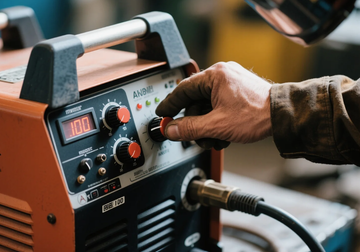4 Key Factors Affecting Welding: Amperage, Voltage, Wire Feed Speed, and Shielding Gas
May 16, 2025

In the welding process, welding current, welding voltage, Wire Feed Speed(welding speed) and Shielding Gas are the key parameters influencing weld quality and size. The interaction of these parameters directly affects penetration depth, weld width, reinforcement, and overall welding stability and efficiency. This article will provide an in-depth analysis of how welding current, welding voltage, and welding speed impact weld characteristics and explore the application and control points in different welding methods to optimize welding performance.

1. Effects of Welding Current on Weld Penetration and Quality
Welding amperage refers to the electric current flowing in the circuit, affecting heat for melting the weld wire and base material. It is directly related to wire feed speed (WFS); increasing WFS raises amperage, resulting in greater weld penetration. Conversely, lower amperage yields less penetration. Amperage is inversely related to contact-tip-to-work distance (CTWD), which is also known as arc length or stick-out. Increasing stick-out decreases amperage, while decreasing CTWD (closer contact tip) increases penetration. Changes in CTWD significantly influence weld penetration and weld bead appearance. Heat input is directly affected by amperage and, combined with travel speed, determines the thermal energy delivered during welding. Excessively high amperage—especially with metal-cored wire—can cause dull, flaky welds. The heat input formula is:
(60 × Amps × Volts) / (1,000 × Travel Speed in IPM) = KJ/in.
2. Effects of Welding Voltage on Weld Quality
Welding voltage is the electrical pressure that influences arc length and amperage. A higher voltage produces a longer arc and wider arc cone, increasing heat input. Maintaining a constant stick-out is essential for consistent weld quality when using CV power sources. If the voltage is too high, it can cause a flatter bead and undercut, while too low voltage may lead to cold lap, humpiness, or excess spatter. Additionally, voltage drops over long cables can reduce actual welding voltage, negatively impacting the finished weld.
3. Effects of Wire Feed Speed(welding speed) on Weld Penetration and Quality
Wire Feed Speed(welding speed), or ‘Travel Speed’ is the rate at which the arc moves along the weld joint, measured in inches per minute (IPM). In semiautomatic welding, operators typically work around 10-12 IPM, while experienced welders may reach 18-20 IPM for higher productivity.
Travel speed impacts heat input—a critical factor when welding heat-sensitive materials like aluminum. Faster travel speeds reduce heat input, helping prevent burnthrough. Conversely, slower speeds can be essential for multipass welds on thick materials to ensure proper pass filling and grain refinement.
Proper control of welding current, voltage, speed and shielding gas is essential for high-quality welds and improved welding efficiency. Adjusting these welding parameters accurately based on material type, thickness, and welding position ensures optimal results. Combining the right welding method, shielding gases, and practical experience allows welders to adapt to complex welding conditions. Mastering these factors is key to producing strong, reliable, and defect-free welds.
Maintaining a consistent travel speed is key:
- Moving too slow causes excessive heat, wide weld beads, and poor penetration.
- Moving too fast creates narrow welds, weak weld toe tie-in, and reduces joint strength.
Optimization of travel speed ensures high-quality welds, good penetration, and reliable weld integrity.
4. Effects of Shielding Gas on Weld Characteristics and Performance
Shielding gas—primarily argon or carbon dioxide (CO₂)—significantly influences weld characteristics and welding performance.
- 100% CO₂ provides deep joint penetration on thicker materials but can result in less arc stability and higher spatter.
- Adding argon to CO₂ enhances weld aesthetics, reduces spatter, and produces more visually appealing welds.
- Mixtures with high argon content yield welds with higher tensile and yield strengths but lower ductility.
- Conversely, higher CO₂ levels improve ductility and crack resistance but lower overall tensile strength and yield strength.
Similar to voltage and wire feed speed (WFS), shielding gas composition influences transfer modes:
- A 75% argon / 25% CO₂ blend enables short-circuit transfer with solid and metal-cored wires.
- 100% CO₂ supports globular transfer when welding with flux-cored wires.
- For thicker materials in spray transfer mode, at higher voltage, an 80% argon / 20% CO₂ mixture with metal-cored wire ensures efficient penetration.

Proper control of welding current, voltage, speed and shielding gas is essential for high-quality welds and improved welding efficiency. Adjusting these welding parameters accurately based on material type, thickness, and welding position ensures optimal results. Combining the right welding method, shielding gases, and practical experience allows welders to adapt to complex welding conditions. Mastering these factors is key to producing strong, reliable, and defect-free welds.
At Arccaptain, we offer a wide range of welding and cutting equipment, including welding machines, cutting machines, and accessories. For your purchasing needs, please check the link below:
MIG Welder: https://www.arccaptain.com/collections/synergic-mig-welder-for-sale
TIG Welder: https://www.arccaptain.com/collections/tig-welder
Stick Welder: https://www.arccaptain.com/collections/stick-welder
Plasma Cutter: https://www.arccaptain.com/collections/plasma-cutter-portable
Welding Accessories: https://www.arccaptain.com/collections/welding-accessories

- 4043 vs. 5356,
- A2 Steel,
- Aerospace Welding,
- Aluminum,
- ARC welding machine,
- aws welding certification,
- Braze Brass,
- cobot welding,
- contact tips,
- Cool Welding Projects,
- Copper Alloys,
- deposition rate in welding,
- Electrode,
- Flux-Cored Weld,
- Fusion Welding,
- Globular Transfer Welding,
- guide,
- military grade aluminum,
- mma welding,
- Multi-Purpose Welders,
- plasma cutter,
- seam welding,
- spool gun,
- spray transfer welding,
- stainless steel,
- stick welder,
- thoriated tungsten,
- tig torch,
- tig torch diagram,
- tig welding,
- tig welding machine,
- Types of Metals,
- Welding,
- welding art,
- welding bead,
- Welding Features,
- Welding Guide,
- Welding gun,
- Welding Helmet,
- welding machine,
- Welding Tips,
- Welding wires
